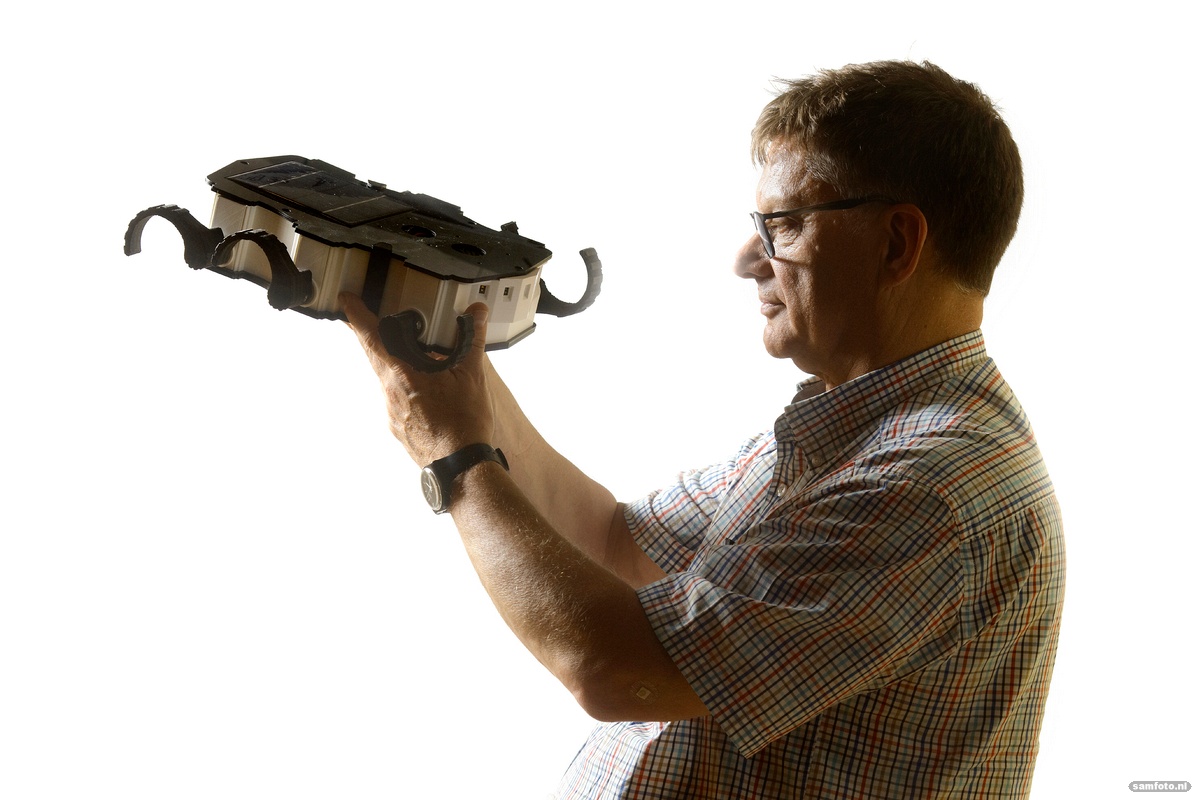Robot Zebro should have landed on the moon in 2022. But the calculations had not foreseen corona. Cooperation with India should speed up the project, explains Chris Verhoeven.
Chris Verhoeven: "The rovers are named after the three space dogs that the Soviet Union shot into space." (Photo: Sam Rentmeester)
With its six independently operated legs, Lunar Zebro, a small autonomous robot, will not be stopped. Once on the moon the small autonomous rover, that only weighs one-and-a-half kilos max, can wander around the moon’s surface looking for tunnels and caves. Even better, send a swarm of these robots and coordinate them to carry out complex search and exploration work. If a couple would tumble into a ravine, no problem. You would still have dozens left.
This in a nutshell is the idea behind the Lunar Zebro student project, now a few years old, supervised by Dr Chris Verhoeven (EEMCS). Until recently the team had hoped to wish Zebro a bon voyage in 2022. But corona put paid to those plans. Last month TU Delft entered into a partnership with the Indian Institute of Space Science and Technology (IISST) which it hopes will push the project up a gear.
What kind of partnership will it be with the IISST?
“It will primarily focus on the exchange of students and researchers. The Dean of EEMCS signed a memorandum of understanding (MOU) in April. But the partnership was only definitive in August when Prime Minister Mark Rutte and India’s Prime Minister Narendra Modi gave their approval during a meeting. As the project is about aerospace, which is of strategic national importance, government leaders must agree. It’s not a cookery club. There are plenty of good researchers and students at the IISST and hopefully they will work on the Zebro project.”
Lunar Zebro already has strong links with India. Can you explain this?
“From the very start we have worked with the Indian Space Research Organisation (ISRO). This is the Indian equivalent of NASA and ESA. The people at the ISRO saw our robots and gave us a challenge. They wanted to know if we could adapt the robots so that we could have them crawl around the moon in a swarm. The idea was to first send one Lunar Zebro to the moon on an ISRO rocket. It could just hitch a ride on one of their rockets as they only weigh two-and-a-half kilos.”
So for the launch you depend on the Indian Space Research Organisation?
“No, we bet on more horses. Lots of organisations and companies can give us a lift. However, our preference is for ISRO as it was involved in the project right from the start. It is partly because of ISRO – or its ‘fault’ if you like – that we started this project. Without ISRO we would never have thought of doing this.”
How far are you now?
“We have built a prototype and are in the throes of testing it at the Netherlands Aerospace Centre. We can imitate the conditions there which the robot will be exposed to during its voyage and stay on the moon. These include high energy radiation, high temperatures and strong vibrations. A rocket launch is a very violent affair. The prototype robot is called Strelka. The one that will eventually be sent to the moon will be called Laika. Our very first version was called Belka. The rovers are named after the three space dogs that the then Soviet Union shot into space in the 1950s and ‘60s. If corona had not turned up, Laika would have been finished. But we could not get various components and travel restrictions of course did not help. Without corona I would now be in India. This type of project benefits from short communication lines, friends and handshakes.”
So the Netherlands will go to the moon soon?
“If it were up to me, yes. Politicians have talked about it a lot recently too. A CDA (a political party, Eds.) Member of Parliament who is a strong advocate for this recently visited us. We should not always think that the Netherlands does not count. We should not think in terms of ‘the Netherlands is small, it cannot do this’. We need to do away with this type of thinking. It does not cost much to go to the moon, only EUR 1.5 million per kilo. I have been buying lottery tickets for years. If I win, Zebro will be on the moon in 2024, even if I have to pay for it myself.”
Do you have a question or comment about this article?
tomas.vandijk@tudelft.nl


Comments are closed.